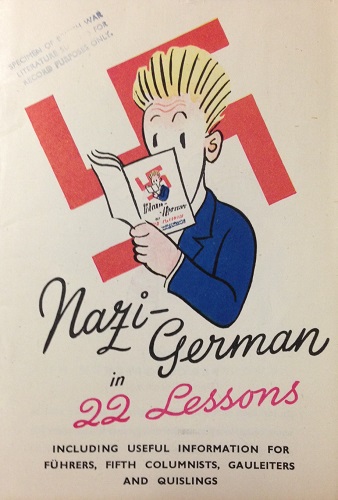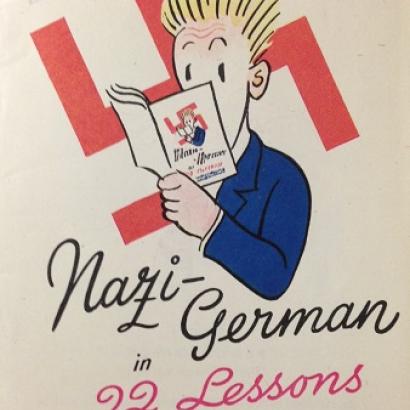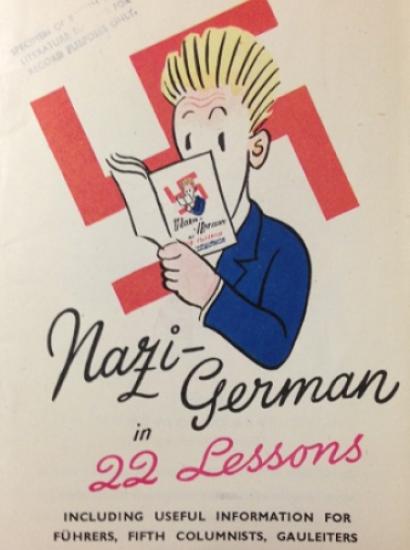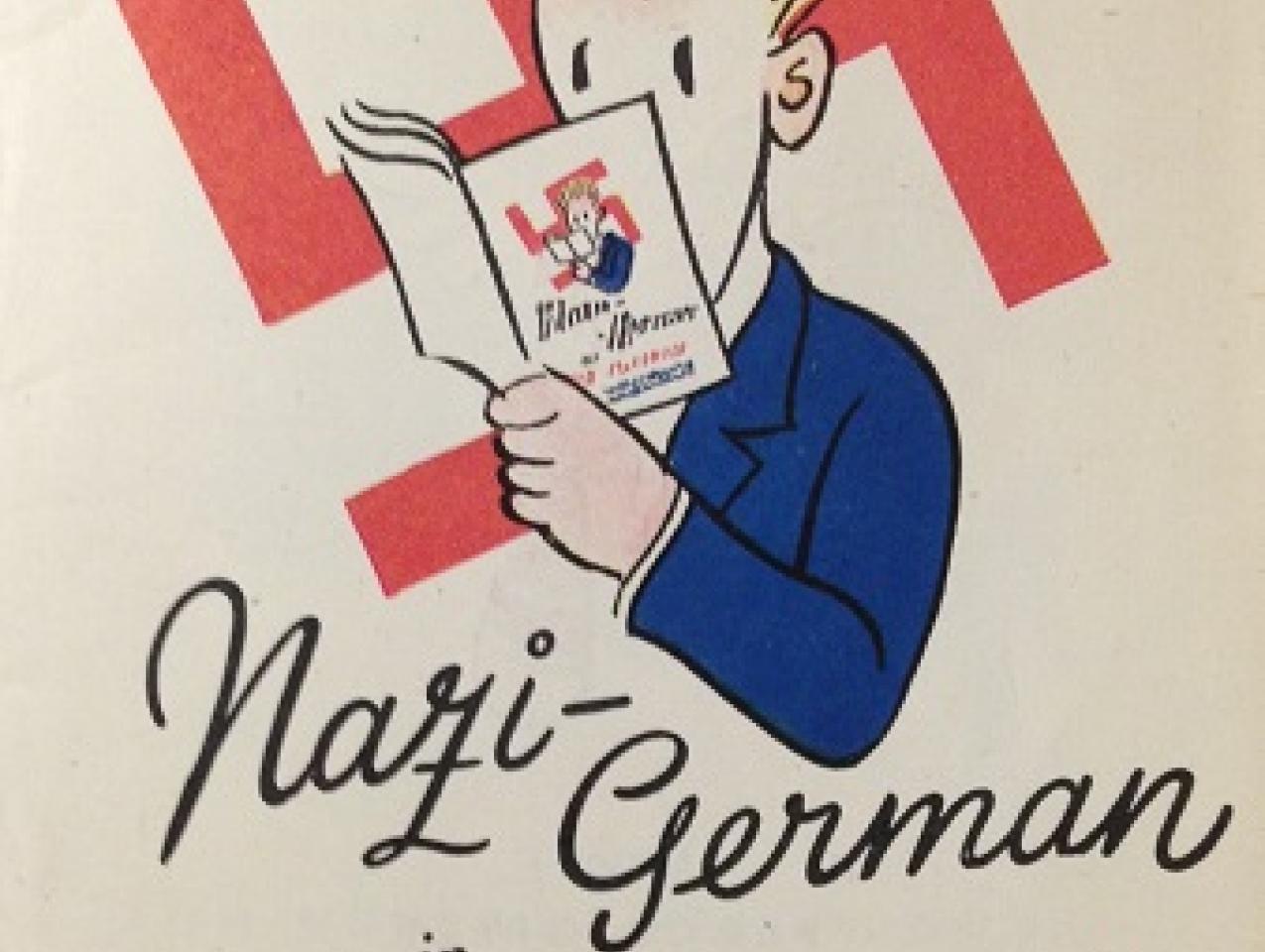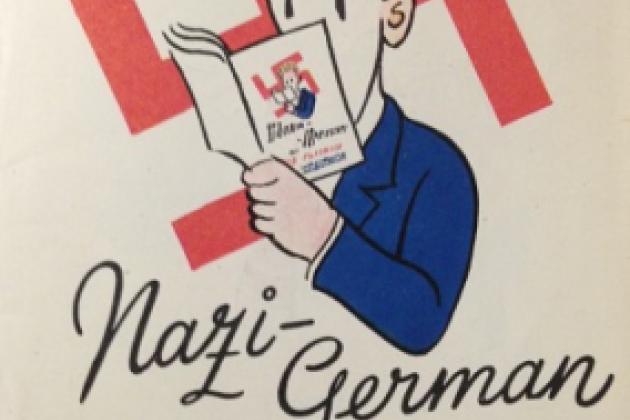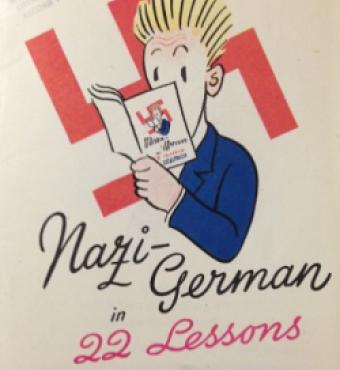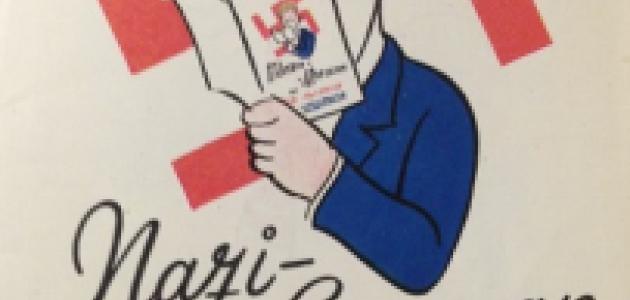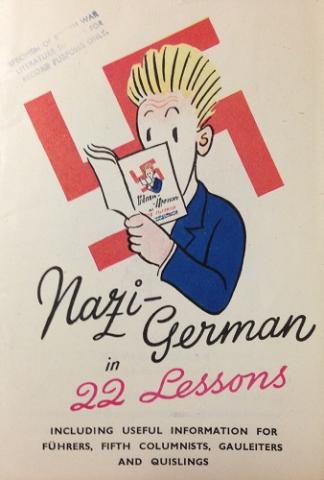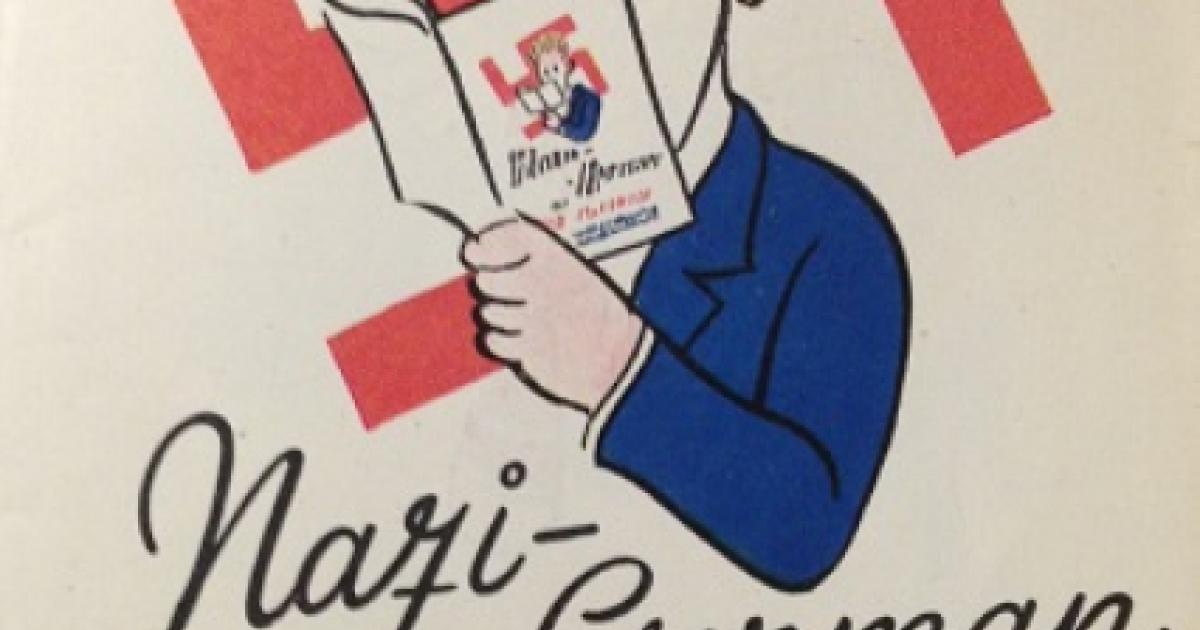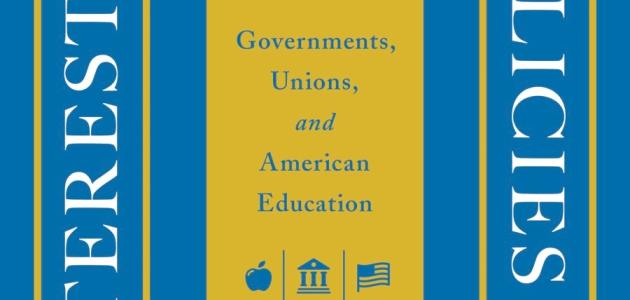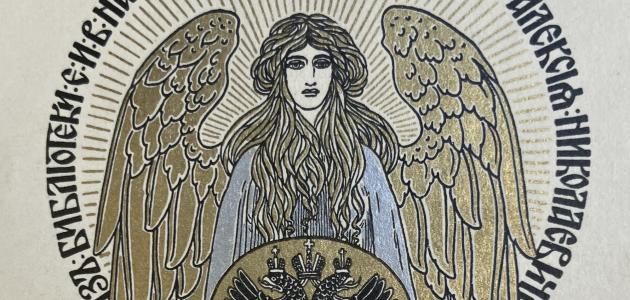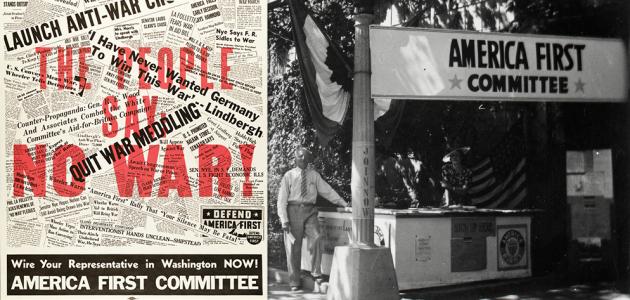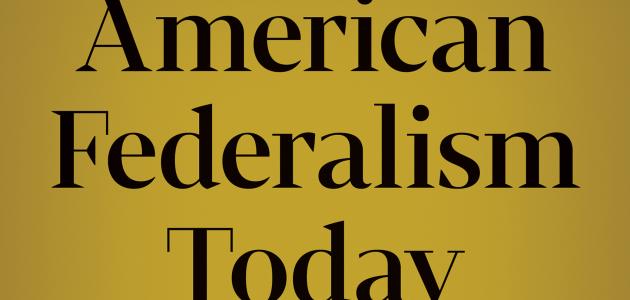By Cameron Van de Graaf, Stanford Class of 2018
In George Orwell’s 1984, doublethink is ingrained in every citizen: to “say that black is white when Party discipline demands it…[but] also the ability to believe that black is white, and more, to know that black is white.” When applied on a societal level, doublethink enables a sufficiently powerful higher authority to redefine the meaning of even seemingly objective facts. In outlining this concept, Orwell borrows heavily from the wartime propaganda of Nazi Germany, as the party leadership employed falsehoods hardly less flagrant than Orwell’s. Indeed, Hitler called these gross mistruths “big lies” in Mein Kampf, and he theorized that the very boldfaced nature of these fabrications renders them among the most powerful forms of public persuasion.
“Nazi-German in 22 Lessons,” a piece of propagandistic British ephemera, targets this willful contortion of language. The leaflet, which was printed by Great Britain’s Ministry of Information during the occupation of France, is made up of a series of cartoons paired with brief captions that satirize various Nazi words and phrases. A parody of a language primer or translation guide, the document sets out to impugn the credibility of the Nazi regime through caustic sarcasm. By inverting the fascist technique of saying the opposite of what one actually means and providing accurate definitions for Nazi terminology, the pamphlet reveals the pernicious absurdity of redefinition.
Taken as a composite, “22 Lessons” purports to provide an introduction to the fictional language of Nazi-German, but in actuality the booklet establishes a divide between the words and phrases used by the Nazi regime and the definitions for those expressions that reflect reality. Because the suggested Nazi meaning of each of the 22 terms is often so far divorced from the actual meaning, the former can come to supplant the latter in the mind of the listener. As Kenneth Burke writes in “The Rhetoric of Hitler’s Battle,” if one is constantly told that peace means war and nonaggression means invasion, one’s worldview becomes dangerously distorted. This conclusion meshes with the cover’s description of the pamphlet as containing “useful information” for such elements of society as “Fuhrers, fifth columnists, Gauleiters, and quislings” (“22 Lessons in Nazi-German,” 1942). All these members of the Nazi hierarchy were subject to mass misinformation and possessed a warped worldview. Of course, this pamphlet was not distributed to those groups; its audience was the free and subjugated peoples of Europe who opposed them. The cumulative effect of each successive caption and cartoon is to persuade the audience that the Nazis’ language is comically illogical, thereby robbing Hitler’s “big lies” of their power.
At a closer textual level, the first and most obvious way in which “22 Lessons” rebukes the Nazi practice of redefinition is by presenting an expression in both English and German, followed by a short description of each term. The conflicts in meaning are jarring. For example, one lesson defines “nonaggression pact” quite succinctly as a “declaration of war.” The latter phrase realizes its sardonic effect from the clear contradiction in meaning with the former; yet the new definition is nonetheless logically compelling in light of the broken Nazi peace pacts with Russia, Czechoslovakia, and others. The reality of tanks rolling over other countries’ borders belies the rhetoric of “nonaggression” officially promulgated by the Nazis. In a similar vein, the Nazi phrase “protective measure” is more accurately translated as “the complete annihilation of a square mile of a city… as, for example, Rotterdam.” A “protective measure,” interpreted in its typical sense, is an act of safekeeping, a definition hardly congruent with the German massacre of vast numbers of civilians. Owing to their topicality and timeliness, the words “declaration of war” and “annihilation of a square mile of a city” are also emotionally charged. Regarding the first definition, Britons would have heard firsthand reports of German atrocities in countries such as Russia and Poland; in the case of the second, the average citizen would have seen photographs depicting the destruction of thirty churches, a thousand warehouses, and twenty-five thousand homes in Rotterdam (Roep & Loerakker, 1999). Through this combination of factual and pathetic appeal, the audience realizes that the German’s actions are the opposite of “nonaggression” or “protection,” at least for anyone free from the enveloping thought cult of Nazism.
Elsewhere in the pamphlet, rhetorical force emerges from the tension between Nazi terms and the accompanying illustrations. This contrast is enhanced by the visual elements’ ability to reach the audience on a visceral level that transcends that of the aforementioned textual techniques. One cartoon shows a corpulent Hitler staring hungrily toward a representation of Great Britain hovering in the air above him. Such a representation highlights the frequently dubious truth of Germany’s pronouncements–here the expression “no further territorial ambition” –at the same time debuting the notion that the Nazi philosophy is liable to explode under the tremendous pressure of its hypocrisy. The propagandist uses Hitler’s gluttonous visage and yearning gaze to imply the existence of a clearly discernible further territorial ambition. Furthermore, the feeling of disgust felt by the viewer in response to Hitler’s bloated form diminishes the credibility of the Nazi definition.
Lesson 6 is more nuanced in its rebuke of Nazism. The image is the specter of a skeletal Nazi SS officer grasping with emaciated fingers toward a smaller female figure. More so than in the earlier cases, this tableau is replete with symbolism; the SS character evokes the sinister qualities of death and decay, and the female connotes virtue and morality. The word identified here is “warmonger”; although the Nazi version of that term labels the Allies thus, not the Axis, the relationship between the two figures shows the opposite to be true. Visually, color plays a pivotal role in reinforcing this contrast; the lady is robed in white and equated with purity, with the wraith clad solely in black. The robes and selection of figures lend a Greco-Roman overtone to the scene; the audience might easily imagine the lady to be some female goddess, her arms held high, struggling valiantly to keep the Union Jack as far away as possible from the corrupting influence of the Nazi. The implication is that the Allies, Great Britain in particular, are fighting to secure the continuation of Western, civilized society against those who would seek to destroy it. They are victims and unwilling combatants, drawn into battle by the one true warmonger: Hitler. This reverses the Nazi line that Germany is the victim, revealing yet another example of language bent to sinister ends.
A final class of cartoons critiques the most blatant German twisting of language: the practice of coining seemingly authoritative terminology that in reality represents nothing. This strategy goes beyond the mere reversal of definitions. Lesson 8 critically examines the putative existence of a “persecuted German minority,” a rationale for invasion coined by Hitler and repurposed by Putin in the present day. This particular drawing carries great emotional appeal; in the sketch, three Nazi soldiers, unconvincingly gussied up in German folk dress, walk hand in hand. Tellingly, one of the three carries a bucket containing dynamite. The rhetorical tactic is the depiction of Nazis as frauds: bungling and laughable ones at that. Yet in spite of, or perhaps due to, the sheer ridiculousness of the image, the cartoon clarifies that the “persecuted German minority” is only an empty façade, for no such people exists. A similar pretense is referenced in Lesson 17, which caricatures Hitler, Goring, and Goebbels. By possessing the nonconforming qualities of black hair, chubbiness, and shortness of stature, these men fail to live up to the Nazi Aryan archetype. Beyond the gut reaction of distaste toward those men, the audience is made to doubt the existence of Aryanism itself: to consider that the “Aryan type” is really just another grand deception fed to the German masses.
Although “22 Lessons” makes use of a range of rhetorical techniques, the unifying thread that runs throughout all of its cartoons, captions, and definitions is the idea that language has an innate influence, independent of its relation to reality. In the hands of the wrong people, the power to redefine language becomes the power to mold a twisted new reality. Hitler, by co-opting the languages of religion and science, stole their credibility and lent his own words a veneer of authority. In employing such tactics, Nazism didn’t merely attempt to distract the populace, confuse the issue, or obfuscate the truth; rather, Hitler and his propaganda apparatus succeeded in redefining the truth, recasting the issue, and reeducating the people. Indeed, Hitler came terrifyingly close to realizing the “New Order” referenced on the final page of “22 Lessons,” a dystopian future equally ominous as that envisioned in 1984.




